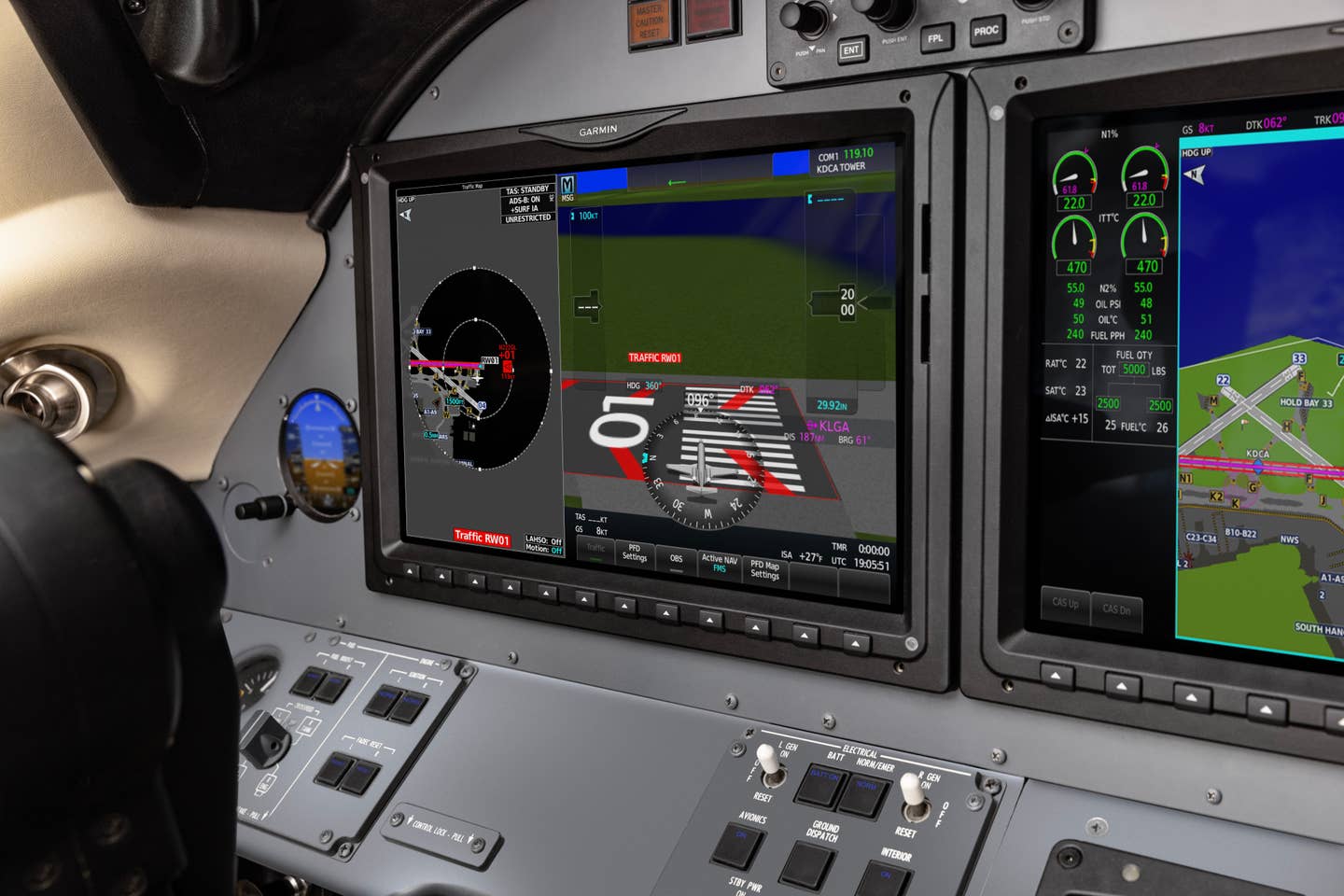Ultimate Issue: Mini EFIS Units Keep Budget, Complexity in Check
If you can live with a small screen, there are ways to save money on a system upgrade, but budget more for extras.

That’s a couple of Garmin GI 275 electronic flight instruments retrofitted in a vintage Bonanza. To save the budget, they’re designed for incremental upgrades because they fit in existing three-and-one-quarter-inch instrument cutouts. [Courtesy: Garmin]
After cutting a new instrument panel and all the other labor-intensive work that tags along with the retrofit, flagship big-screen Electronic Flight Instrument System (EFIS) upgrades come with eye-watering invoices and lots of downtime.
While these big projects could make sense for some, we suspect the majority of buyers look for ways to keep the budget and complexity in check.
Enter small-screen EFIS, otherwise known as a budget glass upgrade. These are generally two solid-state gyro instruments—an electronic attitude display and electronic HSI. While you’ll sacrifice screen real estate, you’ll also save big on install labor because mini EFIS units can fit the existing 3-inch instrument cutouts without having to cut new metal, and in some cases, even retaining the old-school plastic overlay.
Here’s a primer on the budget EFIS market, where Garmin and uAvionix are two standouts, with some words on the realities of a bare-bones avionics upgrade.
The $15K Upgrade
While that isn’t chump change, the $15,000 price point is a realistic budget to set, though you might have some left over. And it’s possible to come out of the upgrade closer to the $10,000 price point, depending on the equipment and options.
Still, after adding up the equipment costs and typical labor, there are always extras that add to the bottom line once the airplane hits the hangar floor.
Truth is, while the aircraft may go into the shop for a couple of electronic flight displays, you might decide to also install a new GPS navigator—or maybe a new audio system. The list of add-ons is long, especially for aircraft that haven’t seen an avionics upgrade since the Clinton years. And those extras add up quickly.
The good news is that a basic budget-priced EFIS upgrade is a fine opportunity to clean up old wiring and address problems in the supporting systems. This includes working on the pitot/static system (aging systems often have leakage, which needs to be fixed before installing the new instruments), replacing old circuit breakers, and perhaps fixing faulty panel lighting. If the aircraft has been sitting for a while (or sourced outside of the U.S.), it might not even have mandate-compliant ADS-B.
Bottom line: Before upgrading, our advice is to address the basic systems first, including the transponder, altitude reporting system, and audio systems.
And speaking of cleanup, even the most basic electronic flight instruments provide the green light for removing the vacuum system. When the system hits the rubbish bin, you’ll enjoy a generous weight saving, while also making room behind the panel for future supportability. Vacuum lines, fittings and filters take up lots of space, making it tough for techs to get their hands in it to work.
Once the fundamentals are covered, it’s time for some glass. We’ll start with Garmin’s budget-based offerings.
Small-Screen Garmin
A staple in Garmin’s lineup is the 3.5-inch QVGA color LCD display-equipped G5, which started life as an experimental EFIS before Garmin earned STC for retrofitting them in certified aircraft through an AML-STC covering nearly 600 aircraft models. The G5 is a no-frills instrument but a step up from spinning mechanical iron gyros.
The battery-backup-equipped G5 attitude indicator is $2,725, and the electronic HSI version with GPS nav interface adapter (for connecting to select VHF navs and GPS navigators) is $3,675. Two G5 instruments connected together offer reversionary ADAHRS should one fail, plus there’s a four-hour battery backup if the aircraft electrics quit.
The G5 DG instrument can work for IFR approaches with its electronic HSI but is limited to VHF nav and GPS sources with digital databases, mainly Garmin GNS 430W/530W, GTN 650/750, and Avidyne IFD navigators. The G5 can also work with Garmin’s discontinued SL30 nav/comm and the current Garmin digital nav/comm radios through an RS-232 serial interface.
A couple of G5 instruments have some limitations because to keep in line with the STC requirements, they can’t replace the entire six-pack of flight instruments. Legally, they’ll replace the existing AI or DG, or a single G5 attitude instrument can replace the rate-of-turn instrument. In our estimation, the tech built into the G5 is aging and compared to newer displays it shows—there is no synthetic vision and no touchscreen. Think utilitarian, and while the instruments fit in an existing full-sized instrument cutout, the G5s have square bezels. That means modifying the plastic panel overlays (or false panels, as they’re sometimes called) in aircraft still equipped.
Depending on your particular interface, and which equipment you plan to connect to (including third-party autopilots), you might need Garmin’s $525 GAD 26 digital converter box. There’s also the $412 GMU 11 magnetometer required for heading resolution on the G5 DG. Without it, the instrument will display GPS track and not magnetic heading.
Increasingly, shops tell us that Garmin’s GI 275 beats the older G5 in popularity, given the advanced feature set and overall design. With a form factor that directly replaces most 3 -inch round instruments, the GI 275 is aimed at incremental upgrades and not requiring cutting new metal—plus, you won’t have to modify the plastic overlays, if equipped.
The instruments have a modern 2.69-inch diameter (active screen size) color capacitive touchscreen and an extremely flexible electrical interface potential compatible with a healthy variety of third-party equipment. They can function as a primary flight instrument, EHSI, CDI, an MFD with synthetic vision, traffic and terrain display, and an engine monitor. However, when used as an attitude instrument and heading display, these functions are locked in place per the AML-STC requirements. The GI 275 product line can be confusing because these instruments are available in many configurations—including one that displays Garmin’s EIS engine instrument system.
But for a typical IFR installation, you’ll want the $4,195 GI 275 ADAHRS, which is the one for use as a primary and stand-alone EFIS because it has the sensors for displaying all primary flight data. Again, it’s locked to display only the flight data. Synthetic vision is a $995 option and downloadable, so you don’t have to bring it to a Garmin dealer when adding it later on.
In a budget glass upgrade, it’s common to install a second GI 275 ADAHRS to replace a round-gauge directional gyro, and it connects with the GMU 11 magnetometer for heading resolution. It can be configured as an EHSI, works with a variety of third-party nav sources, and has mapping, traffic, and weather overlay. A GI 275 ADAHRS with the magnetometer is priced around $4,700. Visit www.garmin.com.
uAvionix AV-30-C
The $2,299 AV-30-C (the “C” means it’s for certified aircraft) with a 3-inch color display fits in a traditional 3 1/4 -inch instrument cutout. The AV-30 has been slowly maturing over the past couple of years, and a recent upgrade that makes it compatible for IFR flying has kicked the capability up a few notches. In its basic form factor, an AV-30 is capable of serving as a primary attitude instrument. In a dual installation (one as an attitude indicator and the other as an electronic heading indicator), the AI is required to be locked when used as the primary, although it does display a heading tape at the top of the display.
The AV-30 is loaded with standard features. The short list includes built-in angle of attack, audio alerting, altitude alerting, and primary slip indication. The AV-30-C has an STC with approved model list (AML) that blankets a wide variety of single-engine aircraft with speeds below 200 knots. It’s approved as a stand-alone attitude indicator, as an electronic DG, as a replacement for a slip-skid indicator (it doesn’t have rate of turn—just a skid ball), and it can be used as the required backup attitude display for the majority of primary EFIS systems. It can even be used with the company’s ADS-B/transponder systems.
A dual-unit installation is fair game for removing the aircraft’s vacuum system, but that could need extra approvals or paperwork on the shop level since the specifics of removing the vacuum system are outside the scope of the instrument’s STC. A pair of AV-30s—one as an attitude display, plus electronic pitot static instruments (in certified aircraft you still have to retain the originals), and the other as a heading indicator—is a good way to give an old VFR panel a new lease on life.
At press time, uAvionix released a major upgrade to the AV-30’s capability thanks to external smart adapters. The new uAvionix AV-HSI smart converter accessory adds long-awaited utility to the previously lacking AV-30 IFR interface, with support for essentially all Avidyne IFD and Garmin GTN/GNS GPS navigators. It will work with the GPS-only Garmin GPS 175/GNC 355/GNX 375 navigators, plus the legacy GPS 155XL. This means you can finally display lateral and vertical course guidance for GPS approaches—plus, the converter also works with Garmin’s GNC 255 nav/comm, Garmin nav/comms, and Trig’s TX56/57 nav/comm radios.
For autopilot interfaces, another adapter—the $299 AV-APA—is in the works for communicating with S-TEC rate-based autopilots—which includes the System 20/30/40/50 models. It enables GPS track hold, GPS desired track, GPS bearing, and GPSS digital steering when using the EHSI.
Speaking of add-on interfaces, for aircraft where panel space is limited, the $299 AV-Link can be used to stream ADS-B traffic data to the AV-30 for displaying standard ADS-B traffic symbology. Any portable ADS-B In receiver that works via the industry standard GDL90 Wi-Fi protocol can interface with the display just as it’s done with an iPad. The AV-Link, which piggybacks between the main wiring harness and the AV-30 itself, is only available in experimental installations, for now. Visit www.uavionx.com.
Aspen's Budget Evoution
The $5,995 Aspen Avionics E5 scales back the features and capabilities built into the flagship 1000 Pro MAX but shares the same drop-in, form-fit chassis that fits the existing holes of mechanical attitude and heading indicators. With a 400×760-pixel TFT Active Matrix LCD screen, the E5 is perhaps the largest of the budget EFIS models with its 6-inch diagonal Matrix LCD screen, and it has a built-in, one-hour backup battery. The E5 shows primary attitude information with altitude, airspeed, and vertical speed, plus an EHSI into a single display with a backup battery.
For IFR capability, the E5 needs to be connected to an IFR panel-mounted navigator but doesn’t require a backup attitude indicator like the Pro models do. It does, however, require Aspen’s ACU (analog converter unit) for connecting with autopilots and VHF nav radios—an accessory that kicks up the price to around $7,000, plus the extra installation effort. You can upgrade the E5 to the Pro MAX version without changing the majority of the hardware. Visit www.aspenavionics.com.
How Much for That?
We think an important step in any budget EFIS upgrade is gathering proposals for larger-screen glass as a comparison. That means bringing the aircraft to the potential installer so they can determine what will and won’t fit.
For sure, the buy-in will be higher, especially when the project requires metal work, but for some—especially with aging eyes—the price delta could be worth it. For others, the smaller screens are a trade-off for an easier installation and lower invoice.
This column first appeared in the Summer 2024 Ultimate Issue print edition.

Subscribe to Our Newsletter
Get the latest FLYING stories delivered directly to your inbox






